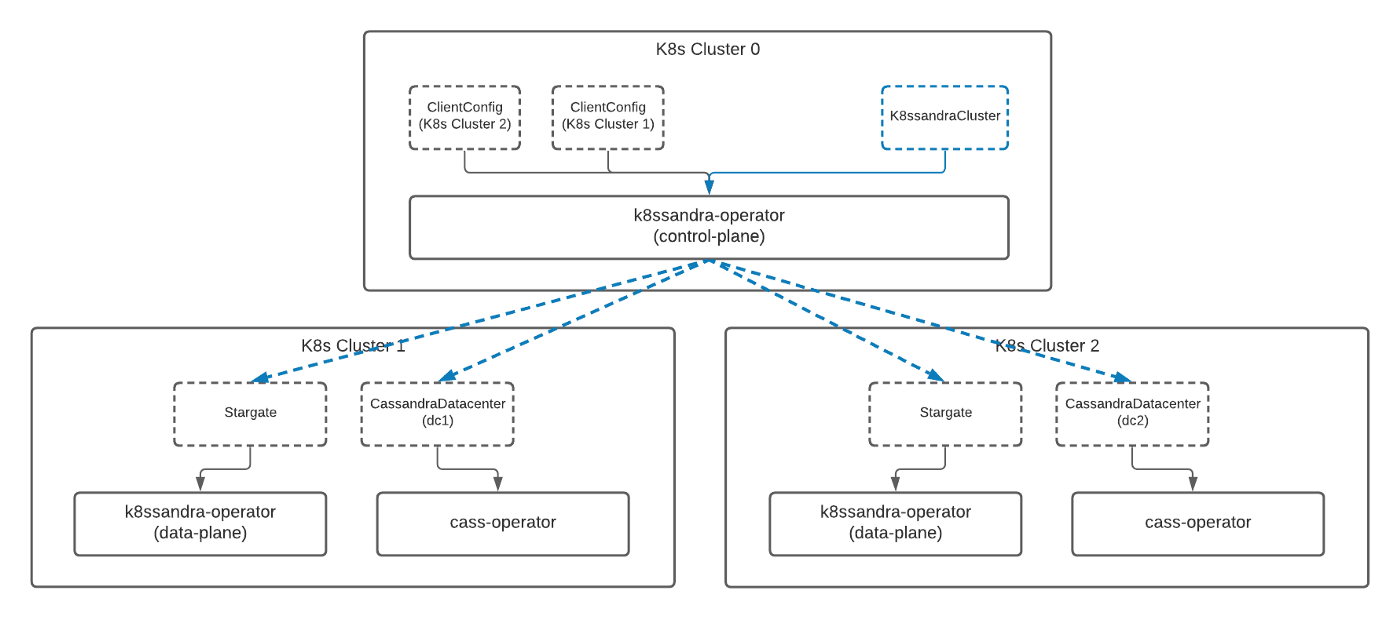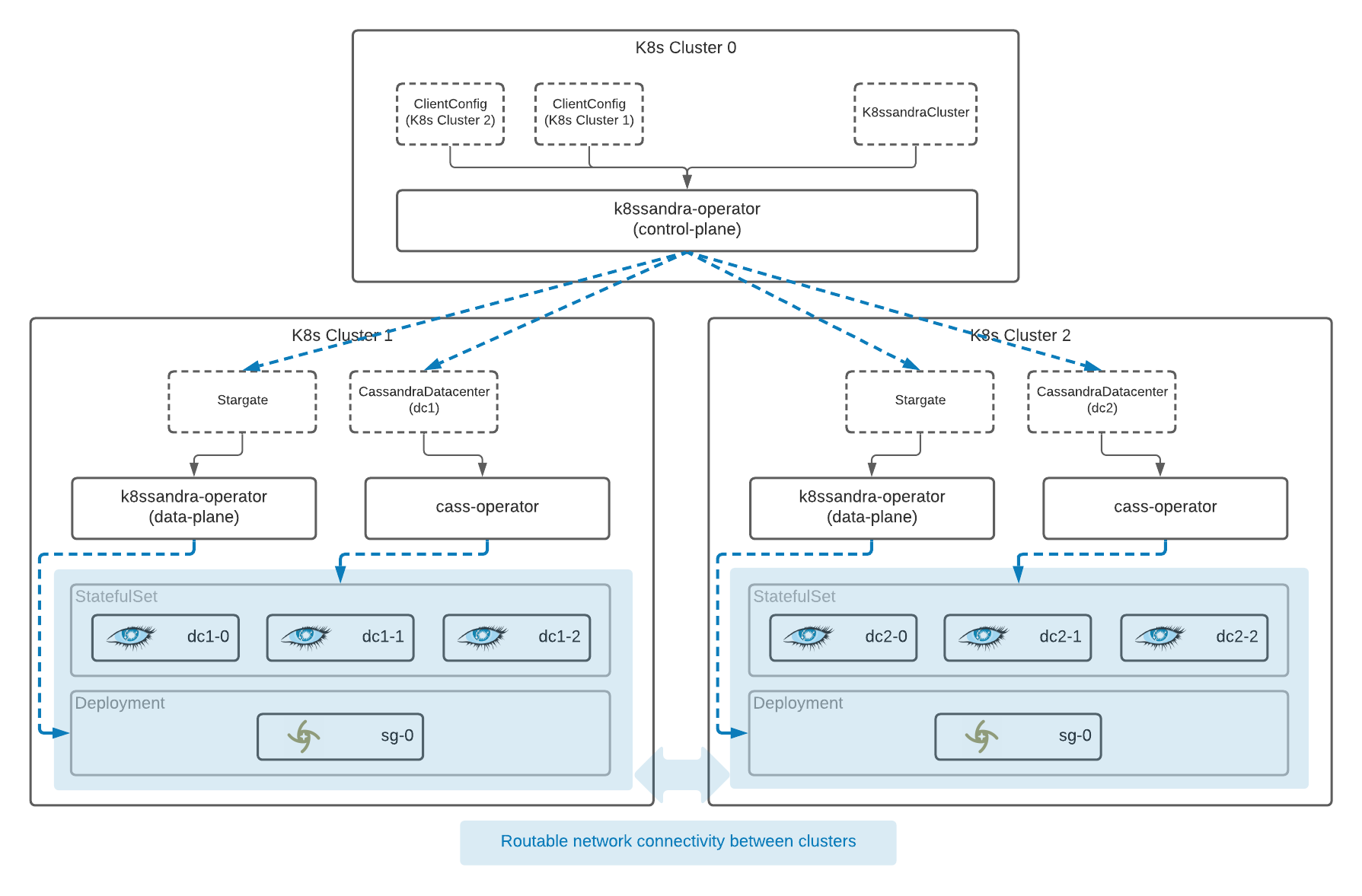K8ssandra Operator architecture
A deeper dive into the K8ssandra Operator architecture.
K8ssandra Operator provides multi-cluster and multi-region support for Apache Cassandra® databases deployed in Kubernetes environments. K8ssandra operator also works in single-cluster and single-region Kubernetes deployments.
You can install K8ssandra Operator in:
K8ssandra Operator consists of two primary components:
The control plane creates and manages objects that exist only in the API server. The control plane can be installed in only one cluster; that is, in the control-plane cluster. While it is possible to deploy a Cassandra datacenter in the control-plane cluster, we recommend that you avoid doing so.
The data plane deploys and manages pods, and the data plane can be installed on any number of clusters. Moreover, the data plane may interact directly with the managed applications. For example, the operator may call the management-api to create keyspaces in Cassandra.
In each cluster, the deployed and managed pods can include Stargate and cass-operator.
Tip: In addition to this topic, be sure to read this K8ssandra Operator architecture deep dive!
Here’s how the K8ssandra Operator components fit together:

In this initial K8ssandra Operator release, we’re introducing a new custom resource: the K8ssandraCluster. This new resource will encompass all of the aspects necessary to install a production-ready, multi-cluster K8ssandra deployment.
To deploy a K8ssandraCluster, we use a custom YAML file. The following shows what a configuration looks like. This example would create a cluster with two data centers deployed across two different Kubernetes clusters. Notice there are two Cassandra 4.0.1 datacenters, dc1 and dc2, that are associated with the two data plane clusters.
apiVersion: k8ssandra.io/v1alpha1
kind: K8ssandraCluster
metadata:
name: demo
spec:
cassandra:
serverVersion: "4.0.1"
storageConfig:
cassandraDataVolumeClaimSpec:
storageClassName: standard
accessModes:
- ReadWriteOnce
resources:
requests:
storage: 5Gi
config:
jvmOptions:
heapSize: 512M
networking:
hostNetwork: true
datacenters:
- metadata:
name: dc1
k8sContext: kind-k8ssandra-1
size: 3
stargate:
size: 1
heapSize: 256M
- metadata:
name: dc2
k8sContext: kind-k8ssandra-2
size: 3
stargate:
size: 1
heapSize: 256M
In this example, you can see that the Cassandra configuration is exposed very similarly to how it was previously within K8ssandra 1.4.x, allowing you to specify data centers, racks, and easy access to the selected version — to name a few.
This should feel very familiar for good reason. Under the hood, the K8ssandra Operator still leverages and delegates control to Cass Operator.
So, what’s different? How does this add anything to the current K8ssandra experience?
One key element of this new configuration is the k8sContext, which is the connection between the CassandraDatacenter and the Kubernetes cluster that is to be its home. With this small yet powerful setting, you can simply define a remote Kubernetes cluster to which a particular data center should be deployed.
You know you can tell the K8ssandraCluster what remote cluster to install a data center within — but how?
The association of a remote cluster is made possible through the addition of another new custom resource: the ClientConfig.
A ClientConfig is essentially the definition of a remote cluster a kubeconfig that the K8ssandra Operator can use to remotely access it. Deploying a data center onto the local Kubernetes cluster, where the “control plane” operator is deployed, doesn’t require any additional settings.
Next, we’ll take a look at the overall architecture of a K8ssandra Operator deployed system. This will show you how the K8ssandra Operator works within each cluster, and also help you understand the difference between a “control plane” and “data plane” deployment.
What happens when you deploy a K8ssandraCluster?
Before deploying a K8ssandraCluster, there are a few other requirements, including the installation of the necessary operators as well as establishing network connectivity between the clusters. It’s important to note that there must be routable network connectivity among the pods in each cluster. The good news is that the virtual networking configurations available within cloud services, such as Google Kubernetes Engine (GKE), make this easy to do.
There are a few different ways to accomplish the prerequisite steps, using Helm or Kustomize. You can learn more about the installation process in our K8ssandra Operator local install topic and its related topics.
This next diagram gives you a quick glimpse at a simple deployment, before the installation of the K8ssandraCluster:

In the configuration above, we have:
While any k8ssandra-operator is capable of operating in the control plane or data plane mode, the control plane is the one responsible for distributing resources to remote clusters. So, the K8ssandraCluster resource should be deployed to the control plane cluster.
When a K8ssandraCluster resource is installed to the control plane cluster, other resources will be distributed to the remote clusters for local reconciliation within those clusters.
Here’s an illustration of our distribution of resources between clusters, after a K8ssandraCluster has been installed :

The control plane in Kubernetes has now distributed new resources to each of the other clusters. From here, the operators installed in each remote cluster will begin to deploy the necessary services within that cluster.
Eventually, a coordinated deployment will take shape that will look like the following:

Once resources have been distributed by the control plane to each data plane cluster, the local operator services within each cluster will manage the deployment of the data services.
The control plane has also taken care of the configuration necessary within the remote clusters to connect each of the distributed data centers, forming a highly available (HA) multi-datacenter cluster.
In addition to coordinating the distribution of resources to remote clusters and configuration, the control plane is also responsible for the collection and rollup of status across the complete cluster. This is another benefit of the K8ssandra Operator that wasn’t possible in prior K8ssandra releases.
K8ssandraCluster custom resource, using K8ssandra Operator, in a local single- or multi-cluster Kubernetes.A deeper dive into the K8ssandra Operator architecture.
Was this page helpful?
Glad to hear it! Please tell us how we can improve.
Sorry to hear that. Please tell us how we can improve.